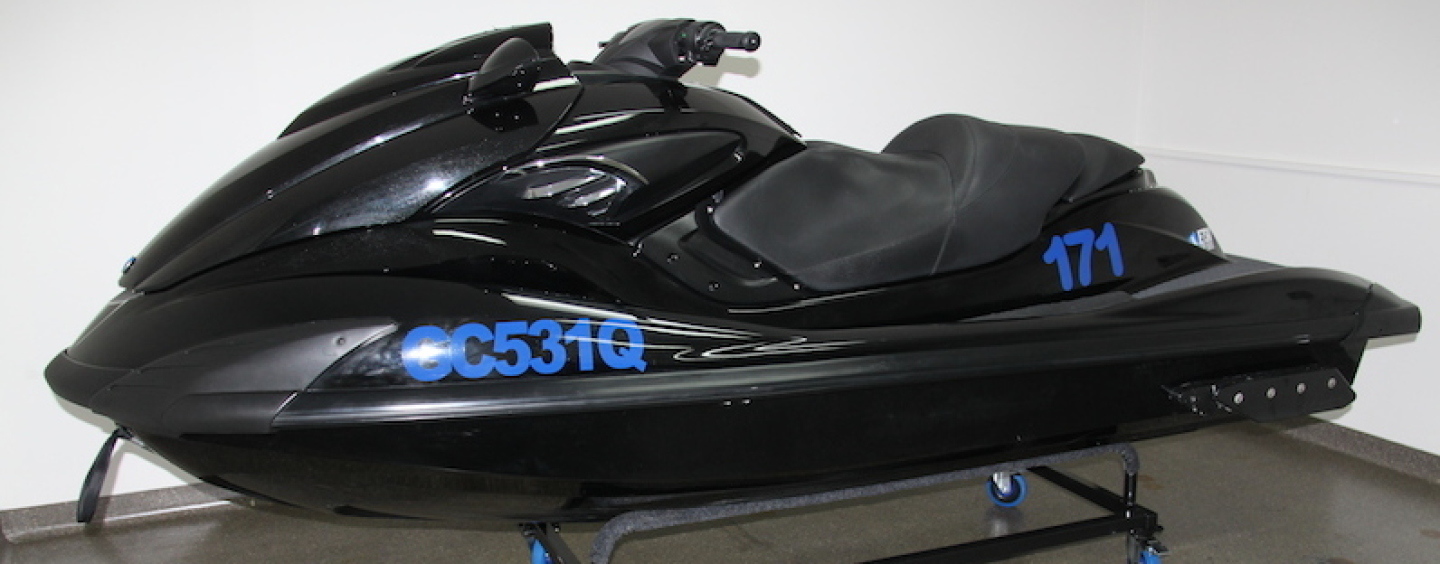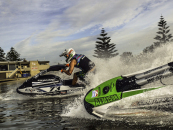Did you know maritime law states a vessel must be maintained as seaworthy at all times? To keep your vessel seaworthy all the time, you have to keep it well serviced. Doing this is one of the best ways to prolong the life of your jet ski. Regular oil changes (to minimise engine wear), regular greasing around bearings (to prevent expensive repairs), and checking the many bolts, clamps, sensors and ECU are all safety “must do’s”.
You will need around four to five hours for a complete service, plus another hour for the trailer. Do keep records of the service and compression results, etc., and consider taking photos of certain parts for future reference.
Ideally, begin the service after a good ride as the ski will be warmed up. This will allow for the extraction of a maximum amount of contaminants from the motor, as they remain suspended in the hot oil for a couple of hours before they settle to the bottom. The more you can remove the better.
1 Washing
It is great to have a really clean ski as this will prevent any salt, sand or other foreign material getting access where it should not.
Secure the trailer wheels from rolling and place it up on a crate or something similar to give a good angle for water to run out of the bung holes. Wash the hull out from front to back taking care not to induce water into the air intake and electrical components. While washing the hull, check the siphon bilge under the coupler (if your ski has it) and ensure it is free from debris, such as sand or seaweed. You may also remove electric bilges for cleaning. The bilge pump may be the difference between getting back to shore or sinking, should water ingress. Check down the back of the hull for any stray bolts, clamps, washers, etc. This will indicate that something requires attention and removal will prevent damage from them ending up in the wrong place.
2 Flushing
Level the ski again to flush and to rewarm/mix the old oil. Always flush ski in a level position. Cooling is compromised when flushing on a hose and if water does not make its way around the head, etc., the heat can be damaging. Limit your time flushing to avoid damaging carbon seals. (Carbon seals help prevent water entry.)
Place your ski on a service trolley to begin the work. If you don’t have a service trolley, a trailer should be just fine. Just place some buckets over the trailer lights and front to avoid injury to your shins!
3 Changing oil
Immediately begin siphoning the old oil out of the engine using an oil siphon pump. (The same pump doubles as a water remover from the hull too.) Using a trolley jack, place the ski on an angle to ensure you have extracted the maximum amount of oil possible.
When the old oil has been completely extracted, replace the oil filter using either an OEM filter or a jet ski specific brand of after-market filter. Take note of the amount of oil extracted and add around 200ml for the loss from the old oil filter, to replace the correct oil level.
QUICK TIP: Always use a high quality marine grade oil that meets or exceeds the standards required by the manufacturer. You can also add an oil water proofer to your oil, which will minimise wear on your engine should water ever gain access, preventing the need for a rebuild. This also helps in the maintenance of supercharged and turbo skis, as it prevents “dry starting” too.
4 Spark plugs
The next step is to remove the spark plugs. Place them on a sheet of paper and record the compression test results under each one. Do two tests for accuracy and always remove power from the injectors to prevent a false read. If the compression is not within specification, the ski will require further diagnosis. Do not continue to operate it as it could worsen and become a much more serious problem.
If the compression test yields good results, replace the plugs according to the ski manufacturer’s recommendations, taking care to check the gap and always use a good anti-seize. Torque should be applied according to the manual.
QUICK TIP: Ensure the plugs are neither too loose nor too tight. If the plugs are too loose, the ski will run badly and there is a safety risk to the rider. If they are too tight, you risk stripping the thread. Place some grease around the neck of the coils to prevent water intrusion.
5 Other checks
Starting at the front, go through the firewall to inspect all of the wiring, mechanical parts and fuel tank retention. Ensure the fuel breather is operating correctly. Check the inside of the hull for integrity and corrosion. Make your way through the rest of the hull toward the back. Grease the steering and any other bearings such as the intermediate.
- Make sure that all hoses are in great condition and secure, the clamps are serviceable and the wiring in good order.
- Thoroughly inspect the reverse or braking systems. Ensure they are greased and tested.
- Adjust the throttle cables and steering to guarantee correct idle speed and true steering.
- Make sure the engine mounts are all intact and in good order.
- Replace the air filter, if required.
- Remove the intercoolers for cleaning. Clean the injectors on skis that have done more than 200 hours or are more than five years old. Inspect the fuel filter for blockage and clean out the tank, if required. For supercharged skis, refer to the workshop manual for maintenance, as they have varying requirements.
- Check the battery for voltage and make sure its electrolytes are topped up. Secure it well. If you have a coolant tank, remove the coolant and replace if it is due or simply ensure the correct level.
- Remove and inspect the pump and impeller of the ski. This is a good opportunity to also inspect the ride plate and intake grate for safety. Once the pump is out, spin it around to check if the bearings are running smoothly. Note if the bearings are not in good condition, replace them immediately to avoid serious engine damage. Remove the cone to inspect for water ingress. If water is present, replace the grease and seals.
- Go over the entire outside of the hull making sure there are no exposed areas, fractures or holes.
- Ensure your seat is clipping down securely and the bonnet secures well.
- Finally, run the ski up on the hose and allow it to settle for a few minutes to ensure the oil level is within specification.
- Some skis require the service schedule to be cleared using the engine management software. This will also alert you to any problems being encountered.
BONUS: Trailer check
Make sure you give your trailer an once-over too. Check the bearings for torque and water ingress. Put some oil on the jockey wheel and winch.
Ensure the following:
- The strap is in good order.
- The tie-downs are strong.
- All rollers spin freely and that the skids are not damaging the hull.
- The underside is free from major rust.
- The springs are intact.
- The brakes are in good order with plenty of wear.
By Mandy Brown, Jet Ski Club
IMPORTANT NOTE: The above tips do not replace professional servicing and only serve as a guide. Jet skis are all different in many ways and need specialised attention to certain matters. Always refer to the owner’s manual for specific instructions that pertain to your ski make and model. Be aware that you may void your warranty if conditions are not met.


























